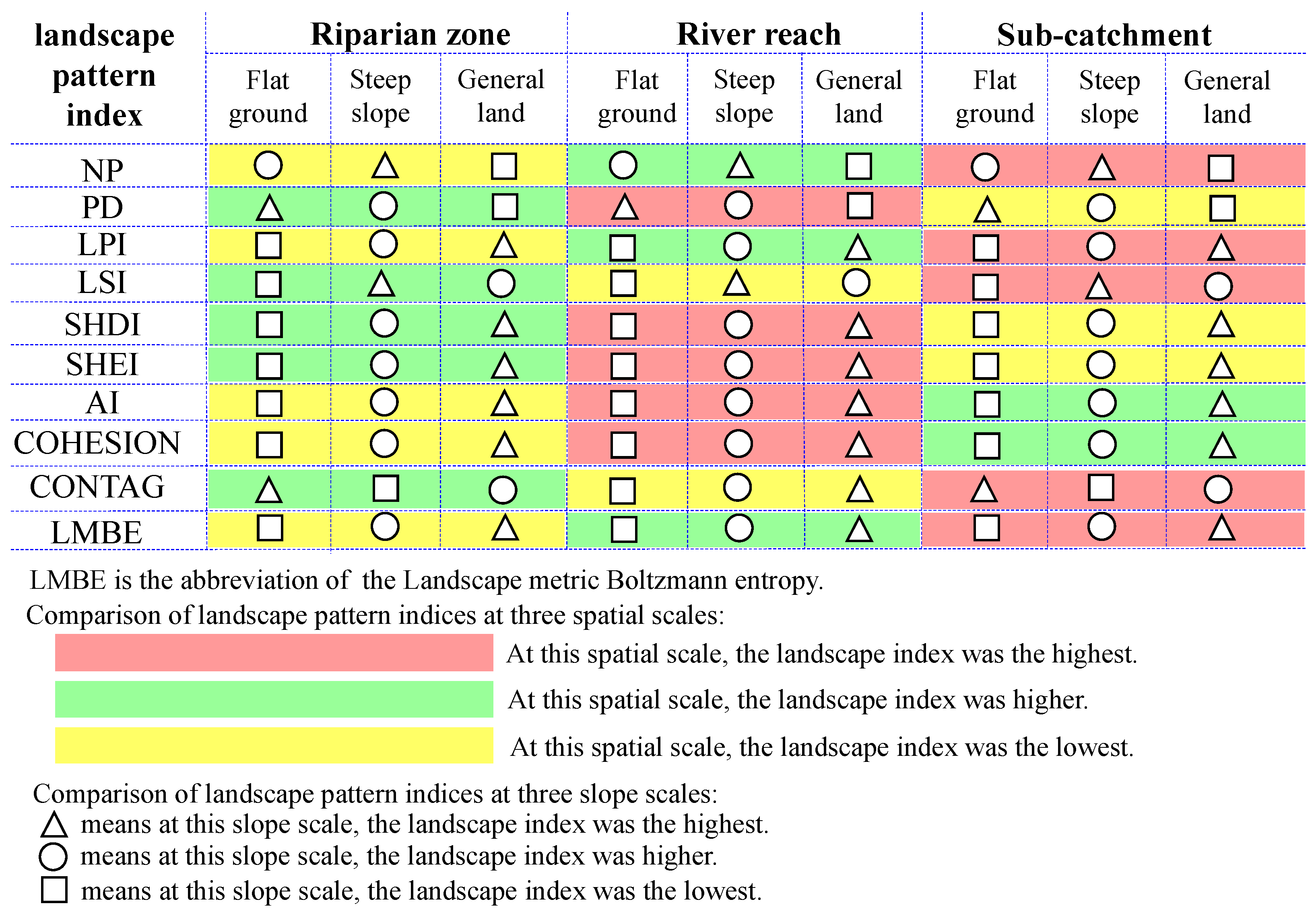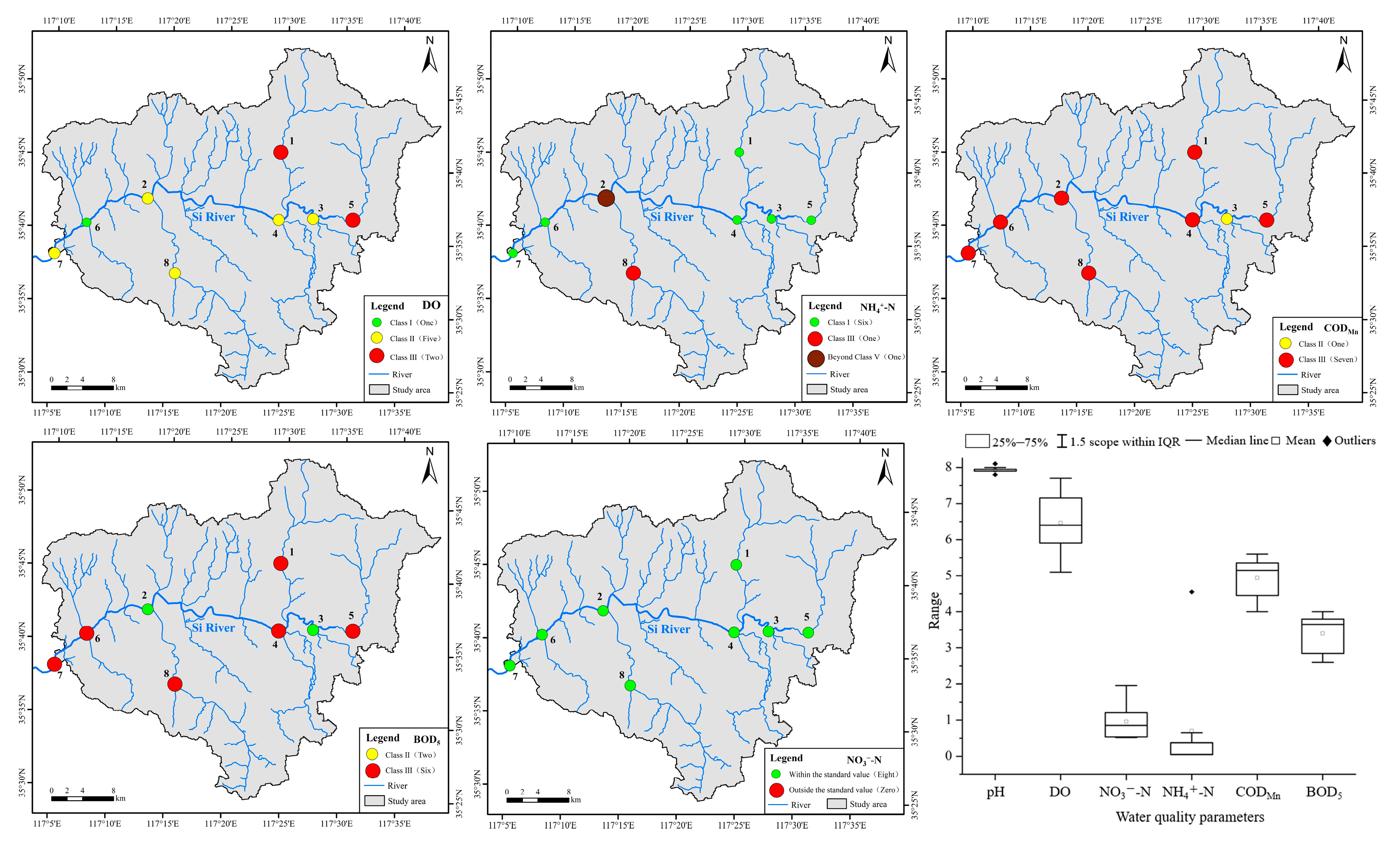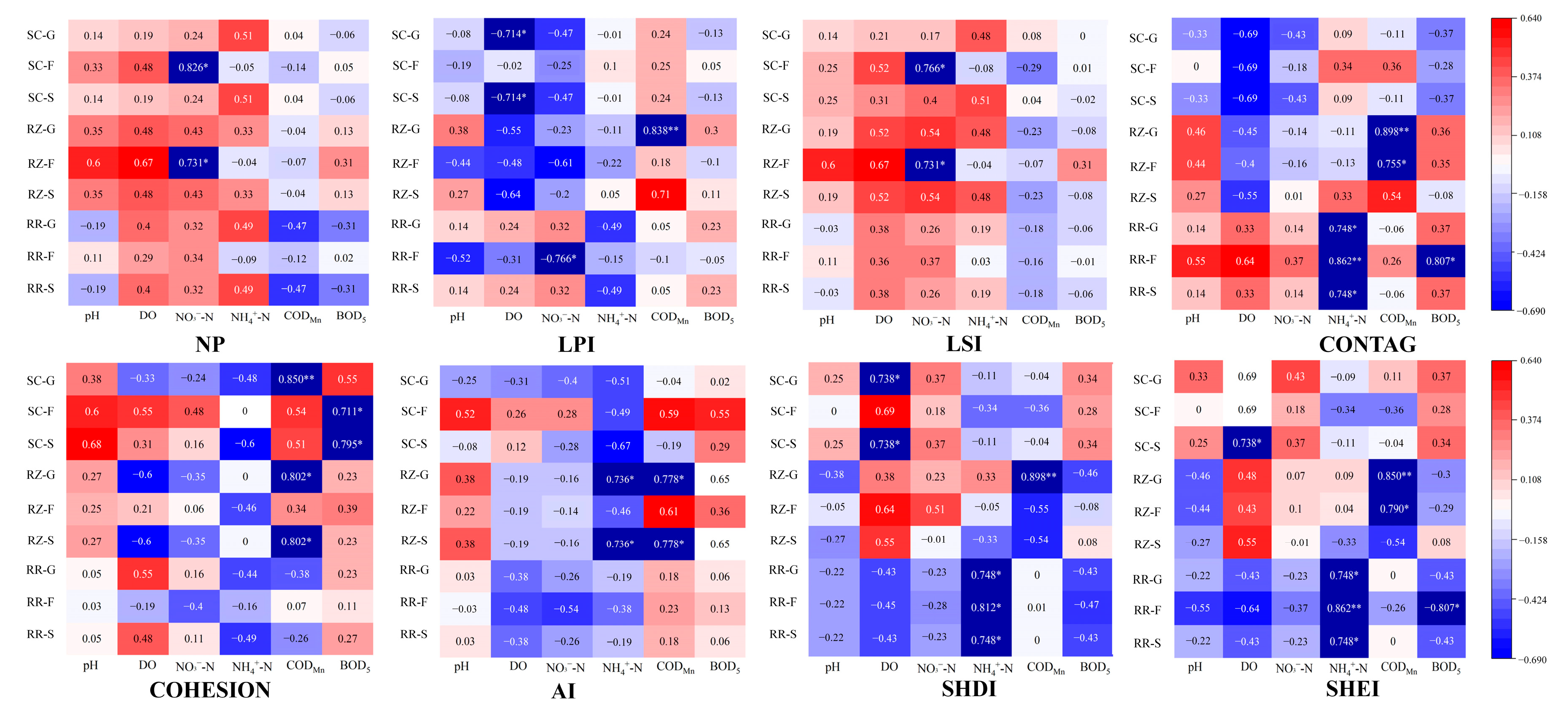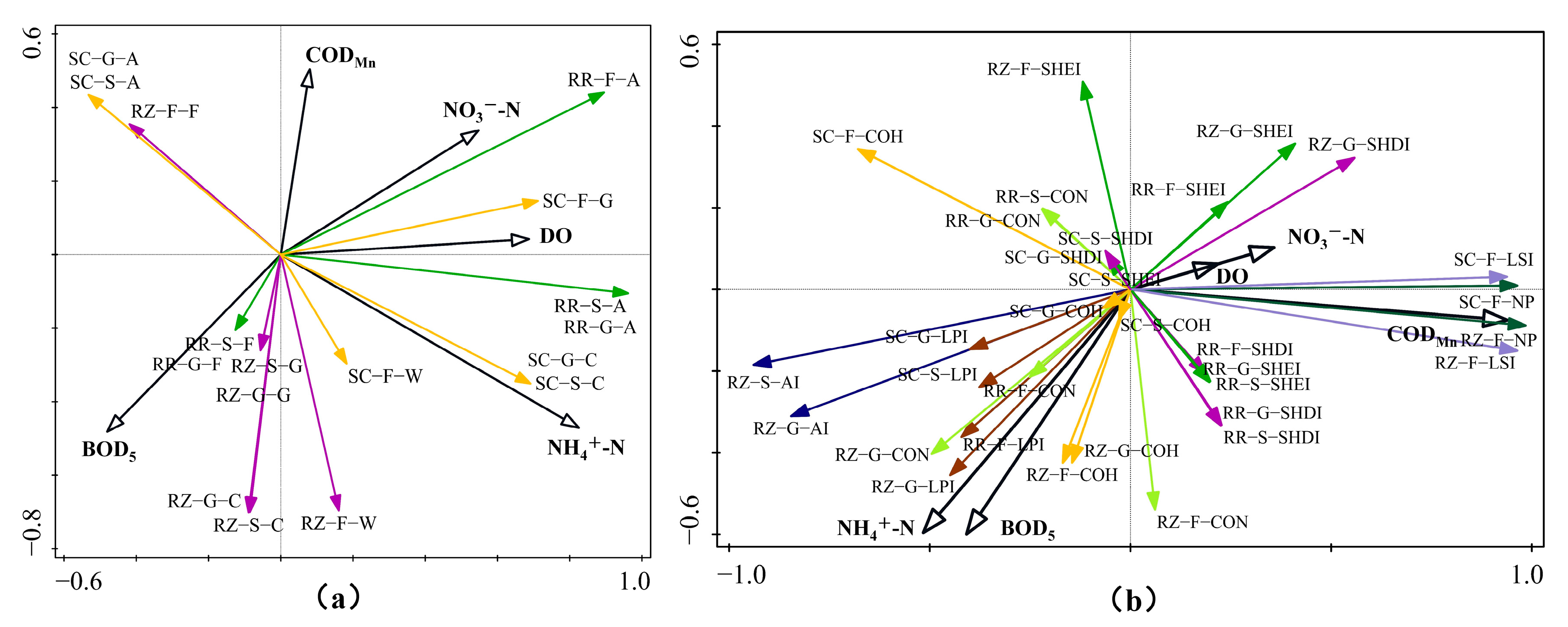Scale Effect of Sloping Landscape Characteristics on River Water Quality in the Upper Reaches of the Si River in East-Central China
Abstract
:1. Introduction
2. Study Area
3. Materials and Methods
3.1. Data Source
3.2. Data Processing
3.3. Analysis Methods
3.3.1. Creation of Spatial Scale
3.3.2. Selection of Landscape Indices
3.3.3. Statistical Analysis
- (1)
- Pearson correlation analysis
- (2)
- Redundancy Analysis (RDA)
4. Results
4.1. Characteristics of Landscape Characteristics at Different Scales
4.2. Temporal and Spatial Characteristics of RWQ
4.3. The Correlation between Landscape Characteristics and RWQ
4.3.1. Correlation between Landscape Types and RWQ
4.3.2. Correlation between Landscape Indices and RWQ
4.3.3. RDA of Landscape Characteristics and Water Quality Indicators
5. Discussion
5.1. Effects of Landscape Types on RWQ
5.2. Effects of Landscape Indices on RWQ
5.3. Scale Response of Landscape Characteristics to RWQ
5.4. Recommendations for Water Quality Protection Based on Landscape Characteristics
6. Conclusions
- (1)
- The landscape types were dominated by arable land and construction land in 2017. The landscape indices at different scales were significantly different. Additionally, RWQ generally met the Class II or III surface water quality standard in September of the same year.
- (2)
- Arable land and construction land were positively correlated with NO3−-N, NH4+-N, and CODMn, meaning that both were “source” landscapes of water quality pollution. The forest was negatively correlated with water quality parameters, meaning that it is an effective “sink” landscape to alleviate the deterioration of RWQ.
- (3)
- The landscape index also contributed greatly to the water quality pollution of the study area. Additionally, landscape indices including NP, LSI, COHESION, CONTAG, AI, SHDI, and SHEI had different degrees of correlation with NO3−-N, NH4+-N, CODMn and BOD5.
- (4)
- There was a spatial scale response to the impact of the landscape configuration in the basin on RWQ of the upper reaches of the Si River. The degree of correlation between landscape characteristics and water quality was the highest at the riparian scale, followed by the river reach scale, and the smallest at the sub-catchment scale. The influence of steeply sloped arable land was higher than that of flat land in the river reach. However, the influence of construction land was higher at the sub-catchment scale than that at the riparian zone and the river reach scales.
Author Contributions
Funding
Data availability statement
Conflicts of Interest
References
- Li, T.; Qiu, S.; Mao, S.X.; Bao, R.; Deng, H.B. Evaluating water resource accessibility in Southwest China. Water 2019, 11, 1708. [Google Scholar] [CrossRef]
- Wei, W.; Li, Z.H.; Huang, Z.Z. Study on the Evolution of Land Use and Landscape Patterns in Urban Riparian Zones. Ecol. Environ. Sci. 2018, 27, 7. (In Chinese) [Google Scholar] [CrossRef]
- Wang, H.L.; Chen, K.F.; Zhang, W.S.; Geng, J.W. Impact of Water Quality in Lakes and Reservoirs under Land-use Changes in Huaihe River Basin. Water Resour. Power 2020, 38, 41–45. (In Chinese) [Google Scholar] [CrossRef]
- Cho, K.H.; Pachepsky, Y.A.; Oliver, D.M.; Muirhead, R.W.; Park, Y.; Quilliam, R.S.; Shelton, D.R. Modeling fate and transport of fecally-derived microorganisms at the watershed scale: State of the science and future opportunities. Water Res. 2016, 100, 38–56. [Google Scholar] [CrossRef]
- Wu, J.H.; Lu, J. Landscape patterns regulate non-point source nutrient pollution in an agricultural watershed. Sci. Total Environ. 2019, 669, 377–388. [Google Scholar] [CrossRef] [PubMed]
- Li, S.H.; Peng, S.Y.; Jin, B.X.; Zhou, J.S.; Li, Y.X. Multi-scale relationship between land use/land cover types and water quality in different pollution source areas in Fuxian lake basin. PeerJ 2019, 7, e7283. [Google Scholar] [CrossRef] [PubMed]
- García-Martínez, M.Á.; Valenzuela-González, J.E.; Escobar-Sarria, F.; López-Barrera, F.; Castaño-Meneses, G. The surrounding landscape influences the diversity of leaf-litter ants in riparian cloud forest remnants. PLoS ONE 2017, 12, e0172464. [Google Scholar] [CrossRef] [PubMed]
- Xu, S.; Li, S.L.; Zhong, J.; Li, C. Spatial scale effects of the variable relationships between landscape pattern and water quality: Example from an agricultural karst river basin, Southwestern China. Agric. Ecosyst. Environ. 2020, 300, 106999. [Google Scholar] [CrossRef]
- Shehab, Z.N.; Jamil, N.R.; Aris, A.Z.; Shafie, N.S. Spatial variation impact of landscape patterns and land use on water quality across an urbanized watershed in Bentong, Malaysia. Ecol. Indic. 2021, 122, 107254. [Google Scholar] [CrossRef]
- Dai, X.Y.; Zhou, Y.Q.; Ma, W.C.; Zhou, L.G. Influence of spatial variation in land-use patterns and topography on water quality of the rivers inflowing to Fuxian Lake, a large deep lake in the plateau of southwestern China. Ecol. Eng. 2017, 99, 417–428. [Google Scholar] [CrossRef]
- Kändler, M.; Blechinger, K.; Seidler, C.; Pavlů, V.; Šanda, M.; Dostál, T.; Krása, J.; Vitvar, T.; Štich, M. Impact of land use on water quality in the upper Nisa catchment in the Czech Republic and in Germany. Sci. Total Environ. 2017, 586, 1316–1325. [Google Scholar] [CrossRef] [PubMed]
- Wang, L.Q.; Han, X.X.; Zhang, Y.Y.; Zhang, Q.; Wan, X.M.; Liang, T.; Song, H.; Bolan, N.; Shaheen, S.M.; White, J.R.; et al. Impacts of land uses on spatio-temporal variations of seasonal water quality in a regulated river basin, Huai River, China. Sci. Total Environ. 2023, 857, 159584. [Google Scholar] [CrossRef] [PubMed]
- Zhang, J.; Li, S.Y.; Jiang, C.S. Effects of land use on water quality in a River Basin (Daning) of the Three Gorges Reservoir Area, China: Watershed versus riparian zone. Ecol. Indic. 2020, 113, 106226. [Google Scholar] [CrossRef]
- Xu, Q.Y.; Wang, P.; Shu, W.; Zhang, H.; Ding, M.J. Investigation of the impacts of land use structure and spatial pattern on water quality in the Yuan River. Acta Sci. Circumstantiae 2020, 40, 2611–2620. [Google Scholar]
- Xu, Q.Y.; Wang, P.; Wang, T.; Shu, W.; Zhang, H.; Qi, S.H. Investigation of the impacts of land use structure and landscape pattern on water quality in the Ganjiang River, Lake Poyang Basin. J. Lake Sci. 2020, 32, 1008–1019. [Google Scholar] [CrossRef]
- Chen, J.X.; Lyu, Y.; Zhao, Z.F.; Liu, H.; Zhao, H.L.; Li, Z.C. Using the multidimensional synthesis methods with non-parameter test, multiple time scales analysis to assess water quality trend and its characteristics over the past 25 years in the Fuxian Lake, China. Sci. Total Environ. 2019, 655, 242–254. [Google Scholar] [CrossRef]
- Shi, P.; Zhang, Y.; Li, Z.B.; Li, P.; Xu, G.C. Influence of land use and land cover patterns on seasonal water quality at multi-spatial scales. Catena 2017, 151, 182–190. [Google Scholar] [CrossRef]
- Mello, K.D.; Valente, R.A.; Randhir, T.O.; Alves dos Santos, A.C.; Vettorazzi, C.A. Effects of land use and land cover on water quality of low-order streams in Southeastern Brazil: Watershed versus riparian zone. Catena 2018, 167, 130–138. [Google Scholar] [CrossRef]
- Wei, W.; Gao, Y.N.; Huang, J.C.; Gao, J.F. Exploring the effect of basin land degradation on lake and reservoir water quality in China. J. Clean. Prod. 2020, 268, 1–12. [Google Scholar] [CrossRef]
- Namugize, J.N.; Jewitt, G.; Graham, M. Effects of land use and land cover changes on water quality in the uMngeni river catchment, South Africa. Phys. Chys. Chem. Earth. 2018, 105, 247–264. [Google Scholar] [CrossRef]
- Jaja, N.; Mbila, M.; Coding, E.; Tsegaye, T.; Odutola, J. Landscape variability of riparian buffers and its impact on soil and water chemistry of an urbanized watershed. Ecol. Indic. 2022, 137, 108777. [Google Scholar] [CrossRef]
- Gonzales-Inca, C.A.; Kalliola, R.; Kirkkala, T.; Lepistö, A. Multiscale Landscape Pattern Affecting on Stream Water Quality in Agricultural Watershed, SW Finland. Water Resour. Manag. 2015, 29, 1669–1682. [Google Scholar] [CrossRef]
- Mainali, J.; Chang, H. Landscape and anthropogenic factors affecting spatial patterns of water quality trends in a large river basin, South Korea. J. Hydrol. 2018, 564, 26–40. [Google Scholar] [CrossRef]
- Jiao, P.; Yang, E.; Ni, Y.X. Experimental study of overland flow resistance coefficient model of grassland based on BP neural network. E3S Web Conf. 2018, 38, 1030. [Google Scholar] [CrossRef]
- Khoi, D.N.; Nguyen, V.; Sam, T.T.; Nhi, P.T.T. Evaluation on effects of climate and land-use changes on streamflow and water quality in the La Buong River Basin, Southern Vietnam. Sustainability 2019, 11, 7221. [Google Scholar] [CrossRef]
- Liu, C.; Wang, Z.Y.; Zhang, J.H.; Chen, Q.W.; Du, Y.B.; Chen, C.; Huang, Y.; Chen, T.Y. Effects of landscape types and landscape pattern evolution on water quality of Hongze Lake. Acta Sci. Circumstantiae 2021, 41, 3302–3311. [Google Scholar]
- Mwaijengo, G.N.; Msigwa, A.; Njau, K.N.; Brendonck, L.; Vanschoenwinkel, B. Where does land use matter most? Contrasting land use effects on river quality at different spatial scales. Sci. Total Environ. 2020, 715, 134825. [Google Scholar] [CrossRef] [PubMed]
- Zhang, L.L.; Liu, R.; Zhang, J.; Xiao, Z.L.; Ji, Q. The influence of sloping landscape features on riverine water quality in upper Yangtze River. Acta Ecol. Sin. 2022, 42, 6704–6717. [Google Scholar] [CrossRef]
- Li, K.; Zhang, B.; Xiao, W.; Lu, Y. Land Use Transformation Based on Production−Living−Ecological Space and Associated Eco-Environment Effects: A Case Study in the Yangtze River Delta Urban Agglomeration. Land 2022, 11, 1076. [Google Scholar] [CrossRef]
- Dymek, D.; Zgłobicki, W.; Baran-Zgłobicka, B. The Impact of Mosaic Land Use and Land Cover on the Quality of River Waters (Case Study: Lubelskie Province, E Poland). Land 2021, 10, 1318. [Google Scholar] [CrossRef]
- Liu, J.; Cheng, F.; Zhu, Y.; Zhang, Q.; Song, Q.; Cui, X. Urban Land-Use Type Influences Summertime Water Quality in Small- and Medium-Sized Urban Rivers: A Case Study in Shanghai, China. Land 2022, 11, 511. [Google Scholar] [CrossRef]
- Cai, H.; Liu, G.M.; Kang, W.H. The effects of sloping landscape features on water quality in the upper and middle reaches of the Chishui River Watershed. Geogr. Res.-Aust. 2018, 37, 704–716. [Google Scholar] [CrossRef]
- Gu, Q.; Hu, H.; Ma, L.G.; Sheng, L.; Yang, S.; Zhang, X.B.; Zhang, M.U.; Zheng, K.F.; Chen, L.S. Characterizing the spatial variations of the relationship between land use and surface water quality using self-organizing map approach. Ecol. Indic. 2019, 102, 633–643. [Google Scholar] [CrossRef]
- Wu, J.H.; Lu, J. Spatial scale effects of landscape metrics on stream water quality and their seasonal changes. Water Res. 2021, 191, 116811. [Google Scholar] [CrossRef] [PubMed]
- Zhang, Q.; Chen, C.L.; Wang, J.Z.; Yang, D.Y.; Zhang, Y.; Wang, Z.F.; Gao, M. The spatial granularity effect, changing landscape patterns, and suitable landscape metrics in the Three Gorges Reservoir Area, 1995–2015. Ecol. Indic. 2020, 114, 106259. [Google Scholar] [CrossRef]
- Wang, L.T.; Wang, S.X.; Zhou, Y.; Zhu, J.F.; Zhang, J.Z.; Hou, Y.F.; Liu, W.L. Landscape pattern variation, protection measures, and land use/land cover changes in drinking water source protection areas: A case study in Danjiangkou Reservoir, China. Glob. Ecol. Conserv. 2020, 21, e00827. [Google Scholar] [CrossRef]
- Zhang, Y.Q.; Liu, S.L.; Hou, X.Y.; Cheng, F.Y.; Shen, Z.Y. Landscape- and climate change-induced hydrological alterations in the typically urbanized Beiyun River basin, Beijing, China. Stoch. Environ. Res. Risk Assess. 2019, 33, 149–168. [Google Scholar] [CrossRef]
- Su, S.; Xiao, R.; Jiang, Z.; Zhang, Y. Characterizing landscape pattern and ecosystem service value changes for urbanization impacts at an eco-regional scale. Appl. Geogr. 2012, 34, 295–305. [Google Scholar] [CrossRef]
- Su, S.; Ma, X.; Xiao, R. Agricultural landscape pattern changes in response to urbanization at ecoregional scale. Ecol. Indic. 2014, 40, 10–18. [Google Scholar] [CrossRef]
- Liu, S.L.; Yin, X.H.; Cheng, F.Y.; Yang, J.J.; Li, J.R.; Dong, S.K.; Zhu, A. Ecosystem Services and landscape change associated with plantation expansion in a tropical rainforest region of Southwest China. Ecol. Model. 2017, 353, 129–238. [Google Scholar] [CrossRef]
- Clément, F.; Ruiz, J.; Rodríguez, M.A.; Blais, D.; Campeau, S. Landscape diversity and forest edge density regulate stream water quality in agricultural catchments. Ecol. Indic. 2017, 72, 627–639. [Google Scholar] [CrossRef]
- Liu, H.Y.; Meng, C.; Wang, Y.; Li, Y.; Li, Y.Y.; Liu, X.L.; Wu, J.S. Establishing the relationship between the integrated multidimensional landscape pattern and stream water quality in subtropical agricultural catchments. Ecol. Indic. 2021, 127, 107781. [Google Scholar] [CrossRef]
- Hu, L.; Li, S.R. Scale Effects of Land Use Structure and Landscape Pattern on Water Quality in the Longchuan River Basin. Ecol. Environ. Sci. 2021, 030, 1470–1481. [Google Scholar]
- Gao, P.C.; Zhang, H.; Li, Z.L. An efficient analytical method for computing the Boltzmann entropy of a landscape gradient. Trans. GIS 2018, 22, 1046–1063. [Google Scholar] [CrossRef]
- Gao, P.C.; Li, Z.L. Aggregation-based method for computing absolute Boltzmann entropy of landscape gradient with full thermodynamic consistency. Landsc. Ecol. 2019, 34, 1837–1847. [Google Scholar] [CrossRef]
- Cho, E.; Choi, M. Regional scale spatio-temporal variability of soil moisture and its relationship with meteorological factors over the Korean peninsula. J. Hydrol. 2014, 516, 317–329. [Google Scholar] [CrossRef]
- Cheng, B.F.; Zhang, Y.; Xia, R.; Zhang, N.; Zhang, X.F. Temporal and Spatial Variations in Water Quality of Hanjiang River and Its Influencing Factors in Recent Years. Environ. Sci. 2021, 42, 4211–4221. [Google Scholar] [CrossRef]
- Yang, M.; Wei, S.; Mwangi, B.N.; Liu, S.; Huang, J.; Li, Y. Horizontal Distribution Characteristics and Environmental Factors of Shrubland Species Diversity in Hainan Island, China. Land 2022, 11, 1047. [Google Scholar] [CrossRef]
- Karmakar, S.; Haque, S.M.S.; Hossain, M.M.; Sen, M.; Hoque, M.E. Water quality parameter as a predictor of small watershed land cover. Ecol. Indic. 2019, 106, 105462. [Google Scholar] [CrossRef]
- Ramião, J.P.; Cássio, F.; Pascoal, C. Riparian land use and stream habitat regulate water quality. Limnologica 2020, 82, 125762. [Google Scholar] [CrossRef]
- Zhang, J.; Li, S.Y.; Dong, R.Z.; Jiang, C.S.; Ni, M.F. Influences of land use metrics at multi-spatial scales on seasonal water quality: A case study of river systems in the Three Gorges Reservoir Area, China. J. Clean. Prod. 2019, 206, 76–85. [Google Scholar] [CrossRef]
- Shi, B.Q.; Bach, P.M.; Lintern, A.; Zhang, K.F.; Coleman, R.A.; Metzeling, L.; McCarthy, D.T.; Deletić, A.B. Understanding spatiotemporal variability of in-stream water quality in urban environments: A case study of Melbourne, Australia. J. Environ. Manag. 2019, 246, 203–213. [Google Scholar] [CrossRef]
- Ferreira, P.; Soesbergen, A.V.; Mulligan, M.; Freitas, M.; Vale, M.M. Can forests buffer negative impacts of land-use and climate changes on water ecosystem services? The case of a Brazilian megalopolis. Sci. Total Environ. 2019, 685, 248–258. [Google Scholar] [CrossRef] [PubMed]
- Zhang, Y.J.; Li, Z.W.; Hu, B.B.; Xie, H.J.; Song, A.Y. Impact of a “source-sink” landscape pattern in an urbanized watershed on nitrogen and phosphorus spatial variations in rivers: A case study of Yuqiao Reservoir watershed, Tianjin, China. Acta Ecol. Sin. 2017, 37, 2437–2446. [Google Scholar] [CrossRef]
- Li, K.; Xie, Y.J.; Sun, W.; Wang, X.R.; Li, Z.H.; Wang, L. Spatial response of lake water quality to multi-scale landscape pattern of lakeside zone in agricultural watershed. Chin. J. Appl. Ecol. 2020, 31, 2057–2066. [Google Scholar] [CrossRef]
- Fan, C.R.; Zhang, C.F.; Shi, X.H.; Sun, B. Nitrogen Loss in Surface Runoff from Hulun Buir Steppe in Different Grazing Systems. Ecol. Environ. Sci. 2020, 5, 951–960. [Google Scholar] [CrossRef]
- Lv, L.T.; Gao, X.Q.; Liu, Q.; Jiang, Y. Influence of landscape pattern on nitrogen and phosphorus output in the Dongjiang River Basin. Acta Ecol. Sin. 2021, 41, 1758–1765. [Google Scholar] [CrossRef]
- Li, J.Y.; Zhou, Y.; Li, Q.; Yi, S.Q.; Peng, L.N. Exploring the effects of land use changes on the landscape pattern and soil erosion of western Hubei province from 2000 to 2020. Int. J. Environ. Res. Public Health 2022, 19, 1571. [Google Scholar] [CrossRef] [PubMed]
- Ji, D.Q.; Wen, Y.; Wei, J.B.; Wu, Z.F.; Liu, Q.; Cheng, Z. Relationships between landscape spatial characteristics and surface water quality in the Liu Xi River watershed. Acta Ecol. Sin. 2015, 35, 246–253. [Google Scholar] [CrossRef]
- Zhou, J.J.; Xiang, J.; Wang, L.Y.; Zhong, G.S.; Zhu, G.F.; Wei, W.; Feng, W.; Huang, M.H. Relationship between landscape pattern and hydrochemical characteristics of Binggou River Basin in eastern Qilian Mountains. Chin. J. Ecol. 2019, 38, 3779–3788. [Google Scholar] [CrossRef]
- Chen, D.C.; Elhadj, A.; Xu, H.L.; Xu, X.L.; Qiao, Z. A study on the relationship between land use change and water quality of the mitidja watershed in algeria based on GIS and RS. Sustainability 2020, 12, 3510. [Google Scholar] [CrossRef]
- Ding, J.; Jiang, Y.; Liu, Q.; Hou, A.J.; Liao, J.Y.; Fu, L.; Peng, Q.Z. Influences of the land use pattern on water quality in low-order streams of the Dongjiang River basin, China: A multi-scale analysis. Sci. Total Environ. 2016, 551–552, 205–216. [Google Scholar] [CrossRef]
- Liu, J.F.; Xu, J.J.; Zhang, X.; Liang, Z.M.; Rao, K. Nonlinearity and threshold effects of landscape pattern on water quality in a rapidly urbanized headwater watershed in China. Ecol. Indic. 2021, 124, 107389. [Google Scholar] [CrossRef]
- Hu, H.B.; Liu, H.Y.; Hao, J.F.; An, J. Influence of Spatial Difference on Water Quality in Jiuxiang River Watershed, Nanjing. Environ. Sci. 2012, 33, 794–801. [Google Scholar]
- Huang, J.L.; Li, Q.S.; Hong, H.S.; Lin, J.; Qu, M.C. Preliminary study on linking land use & landscape pattern and water quality in the Jiulong River watershed. Environ. Sci. 2011, 32, 66–74. [Google Scholar]
- Collins, K.E.; Doscher, C.; Rennie, H.G.; Ross, J.G. The Effectiveness of Riparian ‘Restoration’ on Water Quality–A Case Study of Lowland Streams in Canterbury, New Zealand. Restor. Ecol. 2012, 21, 40–48. [Google Scholar] [CrossRef]
- Mcmillan, S.K.; Tuttle, A.K.; Jennings, G.D.; Gardner, A. Influence of restoration age and riparian vegetation on reach-scale nutrient retention in restored urban streams. J. Am. Water Resour. Assoc. 2014, 50, 626–638. [Google Scholar] [CrossRef]
- Wang, T.; Zhu, B.; Luo, Z.X.; Zhang, J. Nitrate loss from sloping cropland of purple soil. Acta Pedol. Sin. 2010, 5, 962–970. [Google Scholar]
- Jing, X.K.; Li, L.; Chen, S.H.; Shi, Y.L.; Xu, M.X.; Zhang, Q.W. Steep Slope land and surface pollutants. Agric. Ecosyst. Environ. 2022, 339, 108154. [Google Scholar] [CrossRef]
- Meneses, B.M.; Reis, R.; Vale, M.J.; Saraiva, R. Land use and land cover changes in Zêzere watershed (Portugal)—Water quality implications. Sci. Total Environ. 2015, 527–528, 439–447. [Google Scholar] [CrossRef] [PubMed]
- Chen, Z.K.; An, C.J.; Tan, Q.; Tian, X.L.; Li, G.C.; Zhou, Y. Spatiotemporal analysis of land use pattern and stream water quality in southern Alberta, Canada. J. Contam. Hydrol. 2021, 242, 103852. [Google Scholar] [CrossRef] [PubMed]







| No. | landscape Indices | Abbreviations | Calculation Formula | Ecological Meanings |
|---|---|---|---|---|
| 1 | Number of patches | NP | The total number of patches in a landscape type, which can describe landscape heterogeneity and fragmentation. | |
| 2 | Patch density | PD | It is used to describe spatial heterogeneity and fragmentation. | |
| 3 | Edge density | ED | It is used to describe the degree of boundary segmentation. The larger the ED, the bigger the edge between different patches. | |
| 4 | Largest Patch Index | LPI | Proportion of the largest patch in the landscape area. | |
| 5 | Landscape shape index | LSI | Used to reflect the shape complexity of landscape types; the patch shape will affect its internal ecological process. | |
| 6 | Shannon’s diversity index | SHDI | It is sensitive to the uneven distribution of various landscape types and is mostly used for landscape heterogeneity and diversity analyses. | |
| 7 | Shannon’s evenness index | SHEI | If the value is small, it reflects that the landscape is dominated by one or more dominant patch type. On the contrary, it shows that the distribution of each patch in the landscape is relatively uniform. | |
| 8 | Aggregation index | AI | It is used to reflect the aggregation degree of landscape types, and the higher the value is, the higher the aggregation degree is. | |
| 9 | Patch cohesion index | COHESION | For the natural connectivity of the same landscape, the greater the value, the better the connectivity. | |
| 10 | Contagion | CONTAG | Describes the degree of aggregation and the trend of extension between different patches in the landscape. | |
| 11 | Landscape metric Boltzmann entropy | LMBE | This index can discuss landscape stability in terms of landscape structure. |
| Spatial Scales | Slope Scales | Landscape Type | DO | NO3−-N | NH4+-N | CODMn | BOD5 |
|---|---|---|---|---|---|---|---|
| Riparian zone | Flat ground | Water area | 0.833 * | - | - | - | - |
| Forest | - | −0.898 ** | - | - | - | ||
| Steep slope | Grassland | - | −0.790 * | - | - | - | |
| Construction land | - | - | 0.755 ** | - | - | ||
| General land | Grassland | - | −0.790 * | - | - | - | |
| Construction land | - | - | 0.755 ** | - | - | ||
| River reach | Flat ground | Arable land | - | - | 0.857 ** | - | −0.747 * |
| Steep slope | Arable land | 0.675 * | 0.736 * | 0.913 ** | - | - | |
| Forest | - | −0.802 * | - | - | - | ||
| General land | Arable land | 0.675 * | 0.736 * | 0.913 ** | - | - | |
| Forest | - | −0.802 * | - | - | - | ||
| Sub-catchment | Flat ground | Grassland | - | 0.719 * | - | - | - |
| Water area | - | - | - | −0.762 * | - | ||
| Steep slope | Arable land | - | −0.702 ** | - | 0.768 * | - | |
| Construction land | 0.778 * | - | - | - | - | ||
| General land | Arable land | - | −0.702 ** | - | 0.768 * | - | |
| Construction land | 0.778 * | - | - | - | - |
Disclaimer/Publisher’s Note: The statements, opinions and data contained in all publications are solely those of the individual author(s) and contributor(s) and not of MDPI and/or the editor(s). MDPI and/or the editor(s) disclaim responsibility for any injury to people or property resulting from any ideas, methods, instructions or products referred to in the content. |
© 2023 by the authors. Licensee MDPI, Basel, Switzerland. This article is an open access article distributed under the terms and conditions of the Creative Commons Attribution (CC BY) license (https://creativecommons.org/licenses/by/4.0/).
Share and Cite
Liu, F.; Qin, T.; Wang, H.; Liu, S.; Nie, H.; Wang, J. Scale Effect of Sloping Landscape Characteristics on River Water Quality in the Upper Reaches of the Si River in East-Central China. Land 2023, 12, 457. https://doi.org/10.3390/land12020457
Liu F, Qin T, Wang H, Liu S, Nie H, Wang J. Scale Effect of Sloping Landscape Characteristics on River Water Quality in the Upper Reaches of the Si River in East-Central China. Land. 2023; 12(2):457. https://doi.org/10.3390/land12020457
Chicago/Turabian StyleLiu, Fang, Tianling Qin, Hao Wang, Shanshan Liu, Hanjiang Nie, and Jianwei Wang. 2023. "Scale Effect of Sloping Landscape Characteristics on River Water Quality in the Upper Reaches of the Si River in East-Central China" Land 12, no. 2: 457. https://doi.org/10.3390/land12020457





